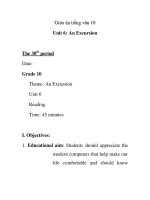Giáo án Tiếng Anh 10 Unit 6: An excursion
Bạn đang xem bản rút gọn của tài liệu. Xem và tải ngay bản đầy đủ của tài liệu tại đây (238.51 KB, 11 trang )
Giáo án English 10
Part A: READING (TCT-30)
• Aims
To help students practice reading more of a certain topic.
• Objectives
To train sts in comprehending the whole paragraph and doing with details.
• Methods and materials
Integrated, mainly communicative skills. Pictures, charts.
• Procedures
Time
Teacher’s activities - Stages
7’
Sts’ activities - possible answer
Warm up: Before you read
T shows sts 4 pictures of 4 places Sts do the task in pairs.
and their descriptions and tells
1. d
3. a
them to match and answer which
they would like to visit.
2. b
4. c
8’
Presentation
T supplies sts with some new Sts take some examples if necessary.
words.
- have (time) off: (explanation)
- cave (n) (picture - translation)
- trip (n): go on a trip/ excursion
- travel (v)
- excursion (n) - day excursion
- visit (v)
Giáo án English 10
- campfire (n) great event
- bring (v) - share (v)
- be going to (str)
weather
(translation)
(n)-problem(n)
Practice
5’
10’
T lets sts read the passage
carefully and then do the task
following.
Task 1: Multiple choices.
Sts do the task.
1. C
10’
Task 2: Answering questions.
2. D
3. A
Sts do the task in pairs.
1. When they have some days off after
1. Where are Lan and her
the first term.
classmates going on a trip?
2. Because they want to understand
2. Why are they visiting some
their geography lessons better and
caves?
many of them have never been inside a
cave.
3. It’s only over 20 km.
3. How far is T. Pagoda from 4. They are going to make a 2-day trip
and have a night campfire. They are
their school?
bringing their own food and sharing
4. What are the sts’ plans for their buses with some other classes to make
trip to Huong Pagoda.
the trip cheap.
5. She’s anxious about her parents’
permission. They may not want to let
Giáo án English 10
her stay the night away from home.
5. What is Lan anxious about?
Why?
5’
Consolidation
After you read
T asks sts to fill in the blanks with
phrases.
1. is going to go 5. their trip
on
6. only problem
2. some caves
7. to persuade
3. want to see
them
4. have learnt
8. her classmates
Part B: SPEAKING (TCT-31)
• Aims
To help students practice giving agreement, disagreement and opinions.
• Objectives
To help sts use structures for showing agreement, disagreement and giving
opinions.
• Methods and materials
Integrated, mainly communicative skills. Pictures, charts.
• Procedures
Time
Teacher’s activities - Stages
3’
Warm up
T asks sts:
Sts’ activities - possible answer
Giáo án English 10
Have you gone on a boat trip?
Sts answers questions.
How do you like it?
Presentation
10’
Task 1: Understanding opinions.
T asks sts to read and understand the Sts read and seek for information.
opinions of the participants on the
boat trip to Lake Michigan.
- What do you know about...?
7’
T supplies sts with some structures
for showing (dis)agreement and
giving opinions:
- What do you think?
- I think...
- Should/ had better + Inf
- I don’t think so
- That’s not a good idea
T asks sts take some examples using
structures.
Practice
10’
Task 2: Making a conversation
Sts do the task in groups.
T asks sts to work in groups
deciding the best seat for each
person.
10’
Task 3:
Sts work in group and a
T asks sts to work in pairs say which
representative will result the
seat they think the most suitable for
Giáo án English 10
them.
5’
opinions of all members in the
group.
Consolidation
T goes over the ways to disagree,
agree with someone else’s ideas and
to show one’s opinion.
Part C: LISTENING (TCT-32)
• Aims
To help students practice listening more of the topic.
• Objectives
To train sts in catching words expected through pictures arranging, listening for
accuracy and for comprehension.
• Methods and materials
Integrated, mainly communicative skills. Pictures, set of pictures.
• Procedures
Time
Teacher’s activities - Stages
5’
Sts’ activities - possible answer
Warm up
T asks sts some questions:
Sts answer the questions verbally.
- Do you often go for a picnic?
(answer may vary)
- When’s the best time for one?
- Why do people go for a picnic?
3’
Presentation
T explains sts some words from Sts repeat the words.
Giáo án English 10
the story and lets sts repeat them.
-glorious -spacious -guitar
-destination -tour -delicious
-left-over -Botanical Garden
Practice
7’
Task 1: Rearranging pictures.
T lets sts look at the pictures, Sts do the task.
guess what they may hear and
a-e-b-c-f-d
listen to arrange the pictures.
Task 2:
8’
Filling in blanks.
Sts do the task.
T lets sts listen to the tape and fill
in the blanks with the word from 1. was just a few
the tape.
2. to pay a visit
3. at the school gate
4. a short tour
Task 3: Answering questions.
12
5. playing some more
T lets sts listen to the tape once
more and answer the questions.
Sts do the task in pairs.
1. The weather was very nice.
2. Yes, it was.
3. The garden was very beautiful.
4. They slept soundly because it was
so peaceful and quiet in the garden.
Giáo án English 10
5. They took pictures, played games,
talked, sang and danced...
10’
Consolidation
T asks sts to work in group Sts work in groups and report their
making their own plan for a picnic plans using: be going to, will Inf, be
on the coming weekend.
V-ing.
Part D: WRITING (TCT-33)
• Aims
To give students practice in writing letters with specific purposes.
• Objectives
To teach sts how and what to write in a confirmation letter.
• Methods and materials
Integrated, mainly communicative skills. Sts’ board.
• Procedures
Time
Teacher’s activities - Stages
Sts’ activities - possible answer
Warm up: Matching
5’
T asks sts to match kinds of letters Sts match the kinds with uses in
with their uses.
pairs.
1. A letter of invitation.
2. A letter of acceptance.
3. A letter of refusal.
4. A letter of complaint.
5. A letter of confirmation.
a. is used to invite someone to
somewhere.
b. is used to accept an invitation.
c. is used to refuse an invitation.
d. is used to complain about
Giáo án English 10
something
e. is used to confirm a request.
5’
Presentation
T tells sts what a confirmation letter
is used for and what are often
written an order, a request.
- In a confirmation letter, there are
often restatement of the request and
expression
of
acceptance/
confirmation.
Task 1:
10’
T asks sts to work in pair finding
requests and confirmation in the 2
letters.
Sts do the task in pairs.
T reminds sts of the opening of the
Requests: “Can you... tomorrow?”
letter: “I’m glad...classmates.”
Confirmation:
“Certainly ... trip”
“I’ll be ... tomorrow”
Practice
20’
Task 2:
Writing confirmation letters.
T asks sts write 2 confirmation Sts write their letters and used them
letters to reply to the letter with for public writing correction.
contents like in the textbook.
5’
Consolidation
Giáo án English 10
T goes over the content of a
confirmation letter.
Part E: LANGUAGE FOCUS (TCT-34)
• Aims
To give students some grammatical and pronunciation points.
• Objectives
Pronunciation: /6/ and /3:/
Grammar: The present Progressive (Future meaning)
Be going to
• Methods and materials
Integrated, mainly communicative skills. Pictures, chart.
• Procedures
Time
Teacher’s activities - Stages
5’
Sts’ activities - possible answer
Warm up: Getting out vowels.
T asks sts to recall the vowels
they’ve leant: /1/ and /i:/, /^/ and
/a:/, /e/ and /%/, /4/ and /0:/, /$/
and /u:/.
Sts listen to the teacher and see who is
the winner with the most correct
vowels.
T reads 20 words and sts get out
vowels from the words.
Pronunciation
2’
Presentation: /6/ and /3:/
T tells the difference between /6/ Sts practice.
Giáo án English 10
(ngắn) and /3:/ (dài).
6’
Practice
T asks sts practice the vowels and
seek the 2 vowels in sentences.
Grammar
7’
Presentation
T reminds sts Present progressive Sts give example of PP with normal
tense with it’ normal uses and its uses.
use to show future meaning.
S+
be
+ V-ing
(am/ is/ are)
- We use PP tense to talk about
Sts give example of PP be going to
things we have planned.
and Simple Future with future
- We use ‘be going to + Inf’ to talk meaning.
about intention and guesses with
certain proofs.
- We use Simple Future not with
those purposes.
Practice
EX1: Choosing correct options.
Sts do the exercises.
1. are you doing
5’
2. is getting married
3. are you going to be
4. am going to be
EX2: Putting the verbs in brackets 5. is going to rain
Giáo án English 10
in PP or ‘be going to’
8’
1. are going
2. are having
3. is going to catch
4. are you putting
EX3: Completing exchanges.
10’
5. is not going to give
1. Are you going to see it?
I’m doing my homework.
2. but we are V-ing/ I am ...
3. What’s she going to ...
4. It’s going to rain ...
5. I’m going to ...
2
Consolidation
T goes over the use of PP and ‘be
going to’ for future meaning.









